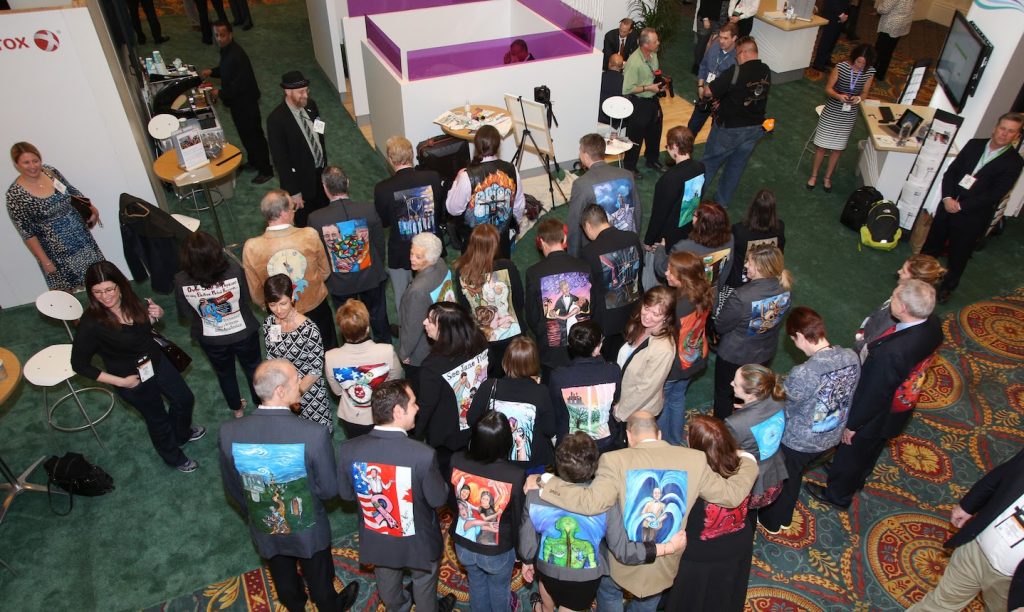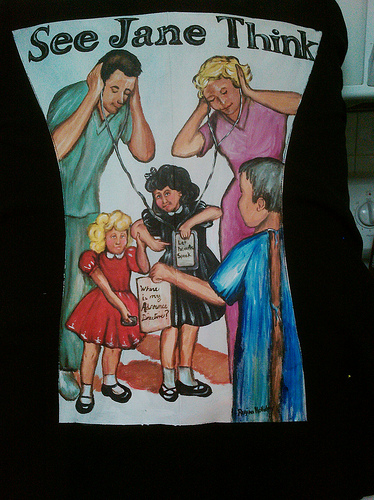 In the past week, the patient engagement/empowerment community marked two major events: the achievement of 400 painted patient stories in The Walking Gallery, and the loss of one of our tribe — Jess Jacobs.
In the past week, the patient engagement/empowerment community marked two major events: the achievement of 400 painted patient stories in The Walking Gallery, and the loss of one of our tribe — Jess Jacobs.
Jess passed away from complications of a complex condition called POTS (Postural Orthostatic Tachycardia Syndrome), made even more complicated by the fragmented, institution-focused (vs. patient-focused) healthcare she received. Jess documented many of her interactions with her health care providers, largely located in the Washington, DC, health care community, on social media–leaving a legacy and evidence on exactly how not to do patient care. You can experience her observations for yourself by searching under her Twitter handle @Jess_Jacobs. You will learn a lot. You will be disheartened and perhaps even enraged…appropriate responses.
Her last tweet, on August 11, 2016, was, “Apparently ‘Vomiting so hard it comes out your nose’ is the motivator I needed to spend more hours trying to get my IV antiemetics refilled.”
So much for patient-centeredness from the U.S. healthcare system.
Last night, many of her friends came together in a virtual wake via Twitter to celebrate Jess’s life, laughter, bravery, and huge contribution to the patient-health care conversation in America. Check out the sharing on Twitter via #UnicornJess.
Regina Holliday, patient activist who created The Walking Gallery and is the project’s chief painter, organizer, and booster, wrote about Jess in her Medical Advocacy blog on Saturday – titled, The First to Fall.
 Hours before Jess died, I had asked Regina how she felt about reaching the 400-jacket threshold. Here is our Q&A exchange…
Hours before Jess died, I had asked Regina how she felt about reaching the 400-jacket threshold. Here is our Q&A exchange…
Jane: What are your thoughts on growing the Walking Gallery to 400 members? Did you ever imagine you were creating a movement when you painted your first jacket?
Regina: The first 5 jackets I painted were called art jackets. I created them for three friends. Those jackets told my family story combined with the mission focus of the person who wore them. In Spring of 2011, I came up with the idea of an entire gallery of patients and providers wearing art jackets that would congregate at different medical conferences and public meetings. I was inspired to do so while visiting the Kaiser Permanente Center for Total Health in Washington, DC. The first gathering of the Walking Gallery occurred in June of 2011. I and 12 other artists painted 56 jackets. Now there are 45 artists in the gallery and we have painted 439 jackets. I personally have painted 381.
I thought from the inception of The Walking Gallery that we were creating a movement.
 Jane: So what was the theme of your first jacket?
Jane: So what was the theme of your first jacket?
Regina: The first art jacket I painted was for Jen McCabe and it was called “Data Prison.” That jacket focused on my demand that patients and family caregivers have rapid access to the digital health record. That jacket was painted prior to the concept of a gallery. The first official jacket of The Walking Gallery was number 6. “Rosetta Stone” for Lygeia Ricciardi. Its primary focus was Lygeia’s ability to explain the complex worlds of government health policy and institutional care to the patient and consumer. Its secondary focus was Lygeia’s role as a mother in advocating for her children through creating a birth plan and making sure breast feeding was supported.
Jane: The Walking Gallery family is global by now. We are walking throughout the US. Where else are we living in the world?
Regina: We have walking members in France, UK, Australia, Canada, Greece, Netherlands, Switzerland, Kenya, Senegal, and South Africa.
Jane: You mystically and artfully channel our personal stories, like my own “See Jane Think” story. They are all so special and moving, but which story have you channeled that was the most challenging? It must be hard to pick one of so many!
Regina: That would be Sherry Reynold’s jacket “DEStiny.” Sherry is @cascadia on twitter and is an amazing thorn in the side of any institution that would like to look the other way when people are being harmed. She is an advocate for AIDS patients, the homeless, and those without a voice in healthcare. For her jacket she wanted to focus on the disastrous effects of Diethylstilbestrol on multiple generations. Sherry was only 12 years old when the medical community discovered the disastrous result of fetal exposure to DES (diethylstilbestrol). This drug had been commonly prescribed to help maintain pregnancies. Young girls were being diagnosed with a rare vaginal cancer that had never been described in youths. Traditionally, onset of this rare disease occurred in women over the age of 60. In the early 1970’s studies began tracking the adverse effects of DES on the mothers and their children. In 1971 the US government ordered doctors to stop prescribing DES. The discontinue use recommendation occurred 20 years after DES was proven ineffective in clinical trials.
I had to do a great deal of research to understand the ramifications of this disease so I could paint about it. This jacket also depicts partial nudity, (as do several others in the gallery) referencing the biblical story of Eve and Lilith from Jewish folklore. Channeling is a good term for what I do when I paint stories. I do my best to become one with the story and that is mentally exhausting. Sometimes, when the painting is shown to the walker they inform me that I painted about parts of their story they did not tell me. It is an honor to paint the story of a life and for a short moment become one with their soul.
Jane: How do you think our WG community will morph and grow over the next 100 jackets as we grow to 500?
Regina: I hope to have more artists help me create the next 100. I have spent the last six months working on a building called Salt and Pepper Studios: Home of The Walking Gallery in Grantsville, MD. We will have visiting artists stay there and hopefully finish a jacket or two. To truly scale up we will need more folks painting as well as new members walking.
***

Why doesn’t love have a billing code? Composition by @ChristineKraft
And so…we will continue to grow our Gallery of patient-story walkers. You can be part of The Walking Gallery project and the growth of Salt and Pepper Studios by contributing at the GoFundMe site. here.
Other friends of Jess Jacobs have been sharing stories about her. You will find posts getting published this week and beyond because Jess’s reach was substantial. Here’s one beautiful example from Dr. Ted Eytan — with a glorious Flickr photo gallery — Remembering Jess Jacobs.
Jess’s website is online at http://jessjacobs.me/.
 Health Populi’s Hot Points: Every one of us has a patient story: more than one. Here’s the one Regina painted for me, capturing my father’s end-stage heart disease and fragmented end-of-life care: See Jane Think, Regina nailed it just about five years ago, channeling a Dick and Jane plotline. And here’s Regina’s storyline on my jacket.
Health Populi’s Hot Points: Every one of us has a patient story: more than one. Here’s the one Regina painted for me, capturing my father’s end-stage heart disease and fragmented end-of-life care: See Jane Think, Regina nailed it just about five years ago, channeling a Dick and Jane plotline. And here’s Regina’s storyline on my jacket.
Jess’s legacy will be honored by those of us who know that the labyrinthine, Rube Goldbergian U.S. health care system lacks system-ness. More importantly, it lacks person-centeredness. As Jess’s pink Post-It note asks: “Why doesn’t love have a billing code?” Welcome to American healthcare.




 Interviewed live on BNN Bloomberg (Canada) on the market for GLP-1 drugs for weight loss and their impact on both the health care system and consumer goods and services -- notably, food, nutrition, retail health, gyms, and other sectors.
Interviewed live on BNN Bloomberg (Canada) on the market for GLP-1 drugs for weight loss and their impact on both the health care system and consumer goods and services -- notably, food, nutrition, retail health, gyms, and other sectors. Thank you, Feedspot, for
Thank you, Feedspot, for  As you may know, I have been splitting work- and living-time between the U.S. and the E.U., most recently living in and working from Brussels. In the month of September 2024, I'll be splitting time between London and other parts of the U.K., and Italy where I'll be working with clients on consumer health, self-care and home care focused on food-as-medicine, digital health, business and scenario planning for the future...
As you may know, I have been splitting work- and living-time between the U.S. and the E.U., most recently living in and working from Brussels. In the month of September 2024, I'll be splitting time between London and other parts of the U.K., and Italy where I'll be working with clients on consumer health, self-care and home care focused on food-as-medicine, digital health, business and scenario planning for the future...